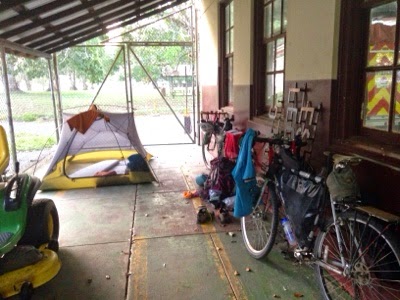In addition to the ants, we saw tons of birds, of course, and two wonderfully cute sloths! We were even lucky enough to observe one in between its 20 hours of daily naps. Less fun were the park's informational signs, snooze-inducing placards with technical language about mosses and other bryophytes. We were also disappointed by the fact that we only saw a few other people on this beautiful Saturday afternoon. Where was everybody?
The next morning we biked out to what we've heard to be Panama's main attraction (just beating out the sloths): the canal. We marveled at the ingenuity of the system, at the fun that the engineers must have had thinking up ways to move massive ships from ocean to ocean. A few ships passed while we were there watching, helped to get in position by two tugboats and then guided through the locks by a number of tiny train cars on the edge of the concrete dividers, their tracks inches from the dropoff to the murky water below.
Our bikes at the canal
If you look closely at the picture above, you can see a small package attached to the side of each bike. We bought cheap ukuleles in Panama City! The perfect travel instrument, they take up very little room and weigh almost nothing, and we're super excited to have more music in our lives. We've waterproofed, padded, and attached them securely; we'll see how long they last.
With the canal, the railroad, the roads, and the wildlife corridor connecting the Pacific and Caribbean coasts, a lot of things here are on the move. Including us, though not very far today. After watching a few gargantuan cargo ships squeeze through the Pedro Miguel locks, we biked out to Gamboa, walking across a horribly rickety, one lane bridge in the process, our sights set on Soberania National Park. We eventually set up camp in the forest along the Pipeline Road, a world-renowned bird and wildlife watching spot. As night fell, it seemed like all the animals were at the foot of our tent, because every few seconds there was a new hiss, chirp, grunt, moan, croak, crash, whine, or whistle, sometimes together, often very near, and always superimposed upon the constant thrum of the jungle. The dense greenery itself seemed to be contributing to the din. It was quite an experience to be out there in the middle of all of it, sweating away.
The next day, a late morning walk on the Pipeline Road drained our energy, as extreme heat and humidity tend to do, so we spent the rest of the day at the Gamboa park making vague, music-like sounds on our brand-new ukuleles. We were going to camp in the park but decided to ask the firemen, whose station was adjacent to the grassy space, if we could instead set up on their lawn. They acquiesced and, even better, offered us use of their exclusive pool! We followed one of the firemen to the pool, finding out that the word "pool" was an understatement for this aquatic complex. A 12-foot diving well, a 25-yard competition pool, and a kiddie pool were together dwarfed by a peeling white grandstand, the only writing on which was, in large, official letters, "NO NECKING." For the only rule, that seemed a poor choice.
Really the pool was probably built by the U.S. when they controlled the canal, and it's fallen now into the hands of the municipality, who has no idea what to do with it. Other than using it as a large billboard to enforce prudence, of course, and giving overheated bicycle tourists an unexpected respite from the heat.
Our next morning ride was pretty uneventful, humid but shaded in the forest, and we then attempted to take the toll road north to Colon. For the first time ever, we were stopped by a policeman and told to turn back and ride on the smaller road. We offered to pay the toll and explained that riding on the smaller road, though it seems safer because of reduced speeds, is much more dangerous for us because there's no shoulder, no space to ride. No luck. He responded by saying that we were here just because it's shorter, not safer. We declined to argue, turned around, and hopped onto the dreaded shoulderless road, which actually did have a gravely shoulder some of the way and wasn't as horrible as we had thought it might be, partly because it had mango trees! We ate four right there, at the biggest stockpile we found, and a whole bunch more throughout the day.
The rest of the day brought us, again for the first time on this trip, to the shores of the Atlantic Ocean! Woohoo! We arrived in the port town of Portobelo, where, tomorrow, we are going to board a small sailboat that will bring us, over the next five days, to the San Blas Islands on Panama's northern coast and ultimately to Cartagena, Colombia. South America, here we come!

















































